Business Economics Report: US and Australian Macroeconomic Analysis
VerifiedAdded on 2023/06/03
|9
|1401
|159
Report
AI Summary
This report provides an in-depth analysis of business economics, specifically focusing on the impact of trade protectionism measures implemented by the US government under President Trump. The report examines macroeconomic stability, utilizing aggregate supply and aggregate demand models to illustrate the effects of tariffs and other protectionist policies. It assesses the short-run and long-run impacts on the US economy, including changes in real GDP, price levels, and welfare. Furthermore, the report extends its analysis to the Australian economy, evaluating the indirect effects of US trade policies, particularly concerning the trade war with China. The study explores potential risks to Australia's export demand and overall economic growth, considering various scenarios and potential consequences of protectionist measures on global economic stability. The report concludes by summarizing the key findings and implications of protectionism on both economies.
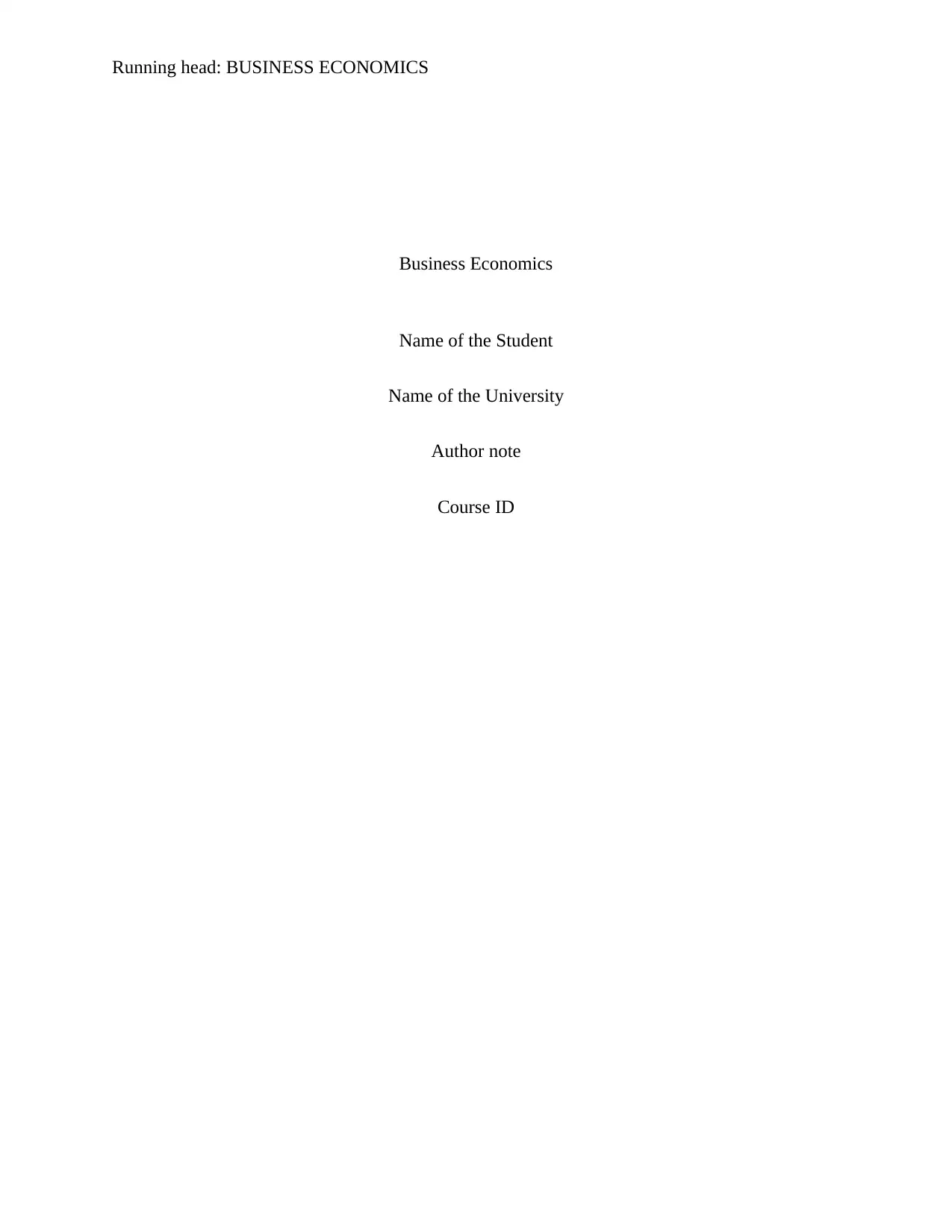
Running head: BUSINESS ECONOMICS
Business Economics
Name of the Student
Name of the University
Author note
Course ID
Business Economics
Name of the Student
Name of the University
Author note
Course ID
Paraphrase This Document
Need a fresh take? Get an instant paraphrase of this document with our AI Paraphraser
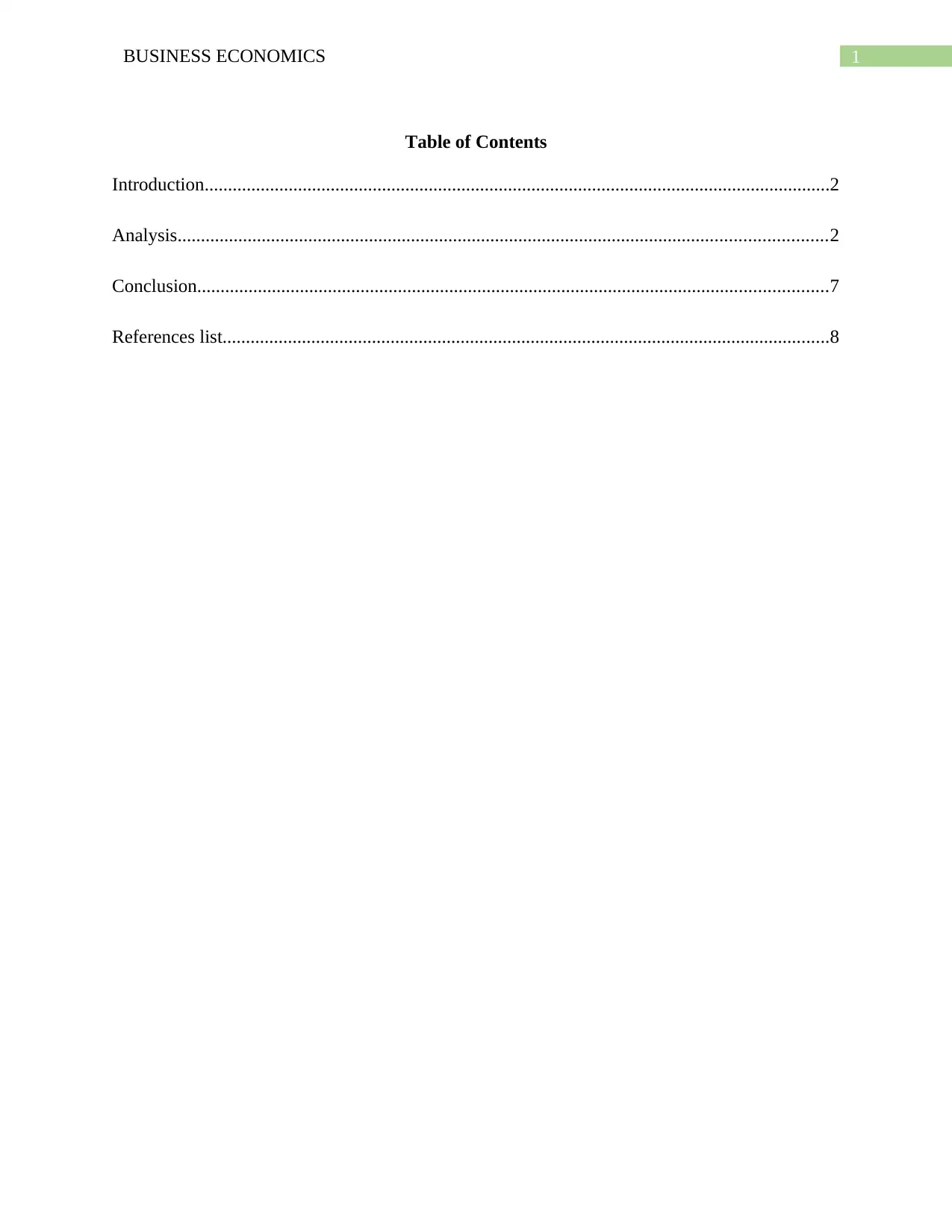
1BUSINESS ECONOMICS
Table of Contents
Introduction......................................................................................................................................2
Analysis...........................................................................................................................................2
Conclusion.......................................................................................................................................7
References list..................................................................................................................................8
Table of Contents
Introduction......................................................................................................................................2
Analysis...........................................................................................................................................2
Conclusion.......................................................................................................................................7
References list..................................................................................................................................8
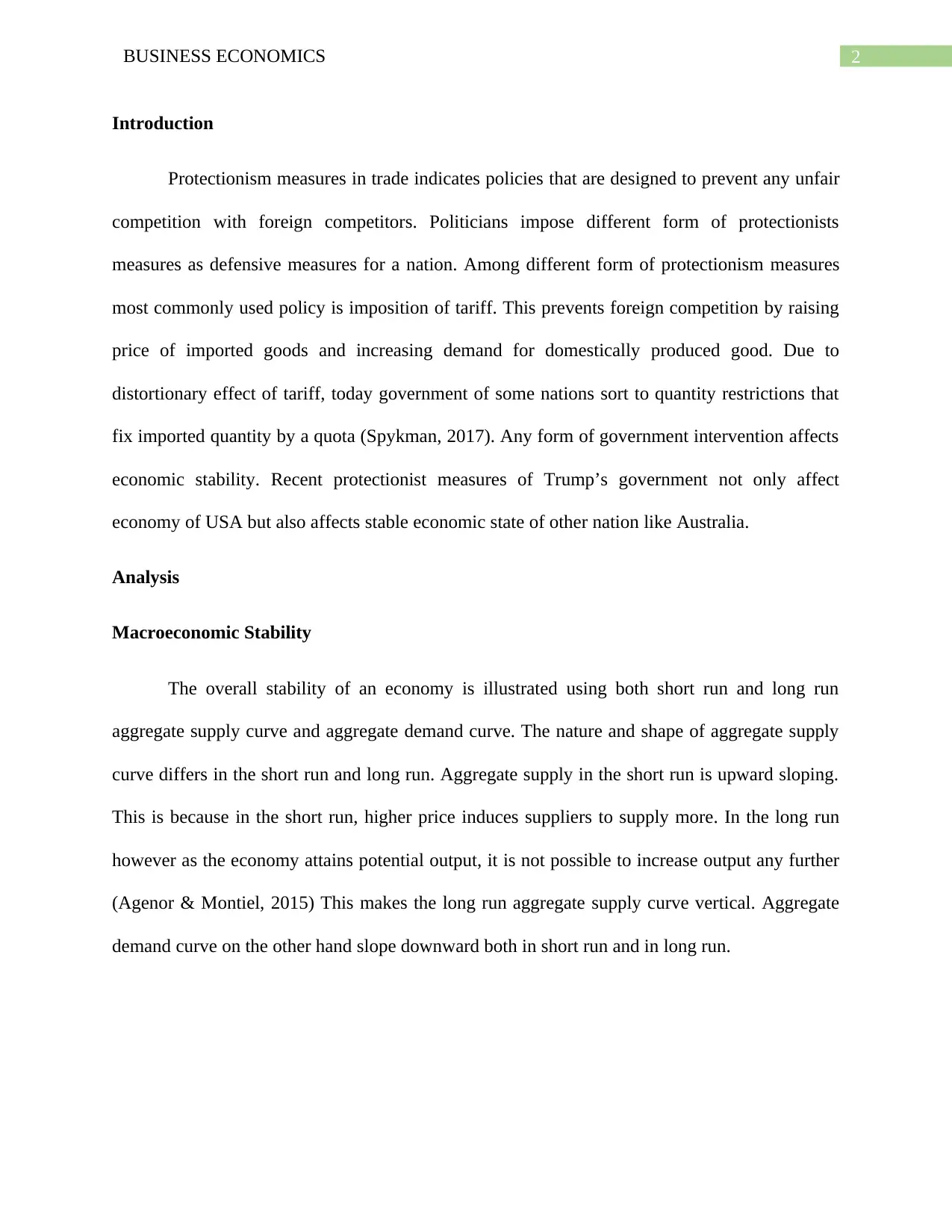
2BUSINESS ECONOMICS
Introduction
Protectionism measures in trade indicates policies that are designed to prevent any unfair
competition with foreign competitors. Politicians impose different form of protectionists
measures as defensive measures for a nation. Among different form of protectionism measures
most commonly used policy is imposition of tariff. This prevents foreign competition by raising
price of imported goods and increasing demand for domestically produced good. Due to
distortionary effect of tariff, today government of some nations sort to quantity restrictions that
fix imported quantity by a quota (Spykman, 2017). Any form of government intervention affects
economic stability. Recent protectionist measures of Trump’s government not only affect
economy of USA but also affects stable economic state of other nation like Australia.
Analysis
Macroeconomic Stability
The overall stability of an economy is illustrated using both short run and long run
aggregate supply curve and aggregate demand curve. The nature and shape of aggregate supply
curve differs in the short run and long run. Aggregate supply in the short run is upward sloping.
This is because in the short run, higher price induces suppliers to supply more. In the long run
however as the economy attains potential output, it is not possible to increase output any further
(Agenor & Montiel, 2015) This makes the long run aggregate supply curve vertical. Aggregate
demand curve on the other hand slope downward both in short run and in long run.
Introduction
Protectionism measures in trade indicates policies that are designed to prevent any unfair
competition with foreign competitors. Politicians impose different form of protectionists
measures as defensive measures for a nation. Among different form of protectionism measures
most commonly used policy is imposition of tariff. This prevents foreign competition by raising
price of imported goods and increasing demand for domestically produced good. Due to
distortionary effect of tariff, today government of some nations sort to quantity restrictions that
fix imported quantity by a quota (Spykman, 2017). Any form of government intervention affects
economic stability. Recent protectionist measures of Trump’s government not only affect
economy of USA but also affects stable economic state of other nation like Australia.
Analysis
Macroeconomic Stability
The overall stability of an economy is illustrated using both short run and long run
aggregate supply curve and aggregate demand curve. The nature and shape of aggregate supply
curve differs in the short run and long run. Aggregate supply in the short run is upward sloping.
This is because in the short run, higher price induces suppliers to supply more. In the long run
however as the economy attains potential output, it is not possible to increase output any further
(Agenor & Montiel, 2015) This makes the long run aggregate supply curve vertical. Aggregate
demand curve on the other hand slope downward both in short run and in long run.
⊘ This is a preview!⊘
Do you want full access?
Subscribe today to unlock all pages.

Trusted by 1+ million students worldwide
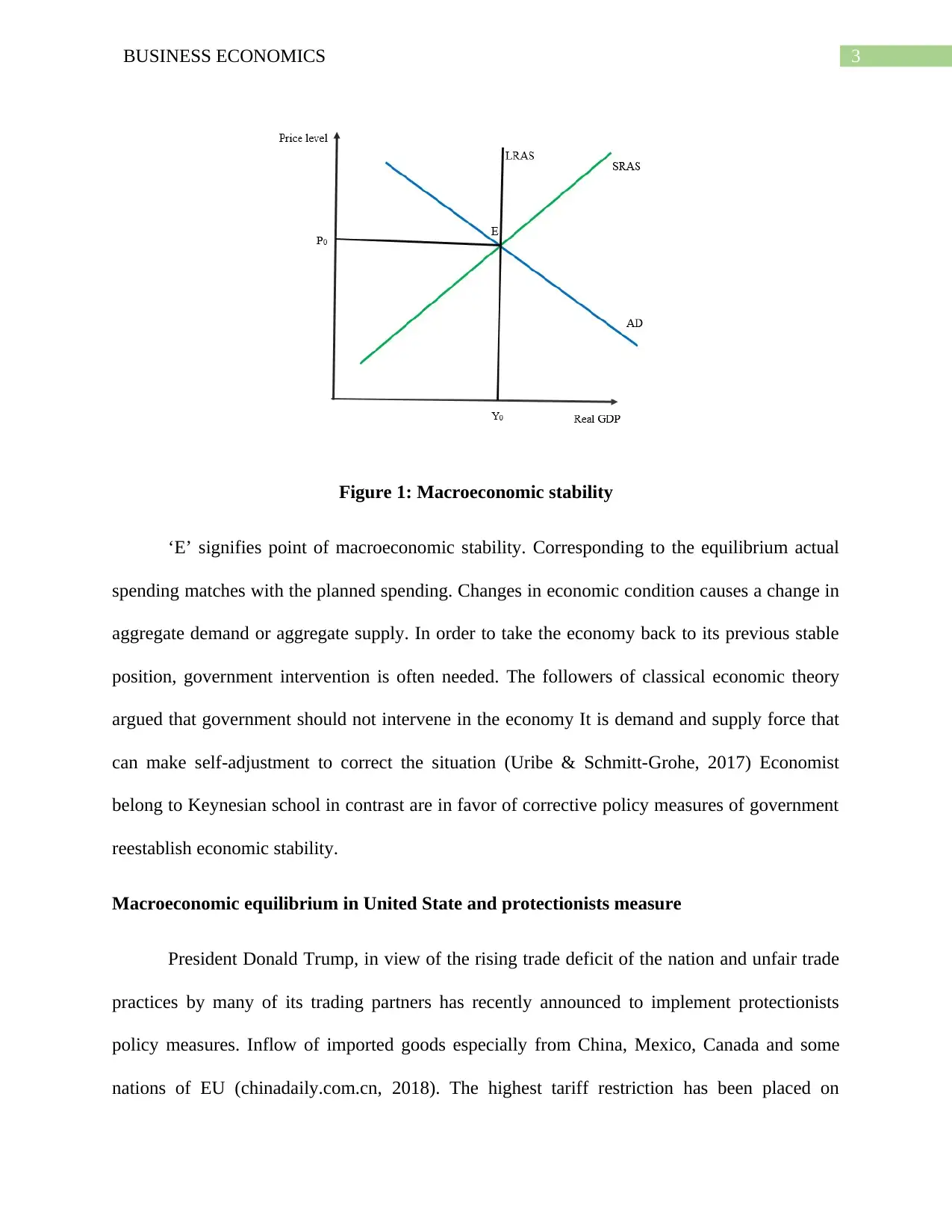
3BUSINESS ECONOMICS
Figure 1: Macroeconomic stability
‘E’ signifies point of macroeconomic stability. Corresponding to the equilibrium actual
spending matches with the planned spending. Changes in economic condition causes a change in
aggregate demand or aggregate supply. In order to take the economy back to its previous stable
position, government intervention is often needed. The followers of classical economic theory
argued that government should not intervene in the economy It is demand and supply force that
can make self-adjustment to correct the situation (Uribe & Schmitt-Grohe, 2017) Economist
belong to Keynesian school in contrast are in favor of corrective policy measures of government
reestablish economic stability.
Macroeconomic equilibrium in United State and protectionists measure
President Donald Trump, in view of the rising trade deficit of the nation and unfair trade
practices by many of its trading partners has recently announced to implement protectionists
policy measures. Inflow of imported goods especially from China, Mexico, Canada and some
nations of EU (chinadaily.com.cn, 2018). The highest tariff restriction has been placed on
Figure 1: Macroeconomic stability
‘E’ signifies point of macroeconomic stability. Corresponding to the equilibrium actual
spending matches with the planned spending. Changes in economic condition causes a change in
aggregate demand or aggregate supply. In order to take the economy back to its previous stable
position, government intervention is often needed. The followers of classical economic theory
argued that government should not intervene in the economy It is demand and supply force that
can make self-adjustment to correct the situation (Uribe & Schmitt-Grohe, 2017) Economist
belong to Keynesian school in contrast are in favor of corrective policy measures of government
reestablish economic stability.
Macroeconomic equilibrium in United State and protectionists measure
President Donald Trump, in view of the rising trade deficit of the nation and unfair trade
practices by many of its trading partners has recently announced to implement protectionists
policy measures. Inflow of imported goods especially from China, Mexico, Canada and some
nations of EU (chinadaily.com.cn, 2018). The highest tariff restriction has been placed on
Paraphrase This Document
Need a fresh take? Get an instant paraphrase of this document with our AI Paraphraser
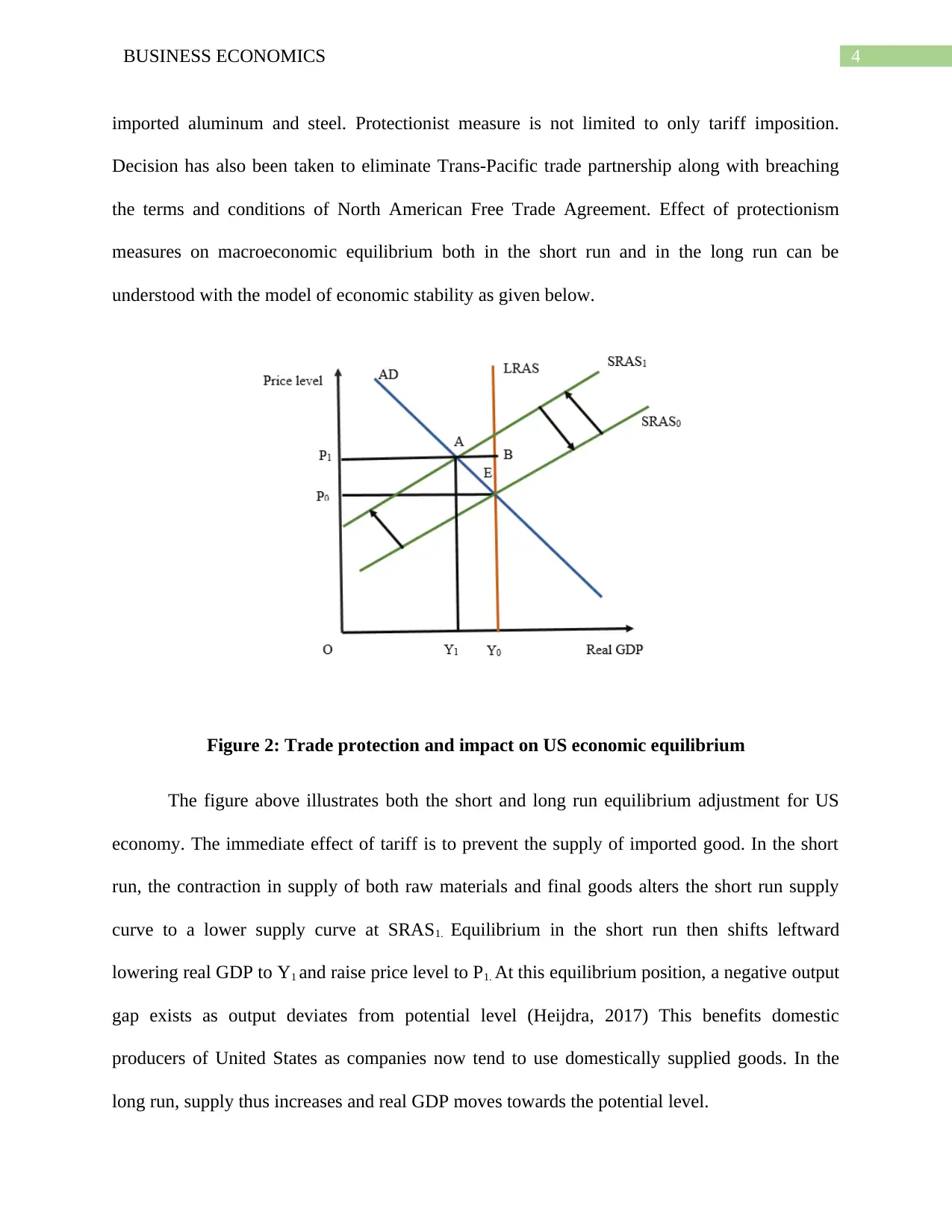
4BUSINESS ECONOMICS
imported aluminum and steel. Protectionist measure is not limited to only tariff imposition.
Decision has also been taken to eliminate Trans-Pacific trade partnership along with breaching
the terms and conditions of North American Free Trade Agreement. Effect of protectionism
measures on macroeconomic equilibrium both in the short run and in the long run can be
understood with the model of economic stability as given below.
Figure 2: Trade protection and impact on US economic equilibrium
The figure above illustrates both the short and long run equilibrium adjustment for US
economy. The immediate effect of tariff is to prevent the supply of imported good. In the short
run, the contraction in supply of both raw materials and final goods alters the short run supply
curve to a lower supply curve at SRAS1. Equilibrium in the short run then shifts leftward
lowering real GDP to Y1 and raise price level to P1. At this equilibrium position, a negative output
gap exists as output deviates from potential level (Heijdra, 2017) This benefits domestic
producers of United States as companies now tend to use domestically supplied goods. In the
long run, supply thus increases and real GDP moves towards the potential level.
imported aluminum and steel. Protectionist measure is not limited to only tariff imposition.
Decision has also been taken to eliminate Trans-Pacific trade partnership along with breaching
the terms and conditions of North American Free Trade Agreement. Effect of protectionism
measures on macroeconomic equilibrium both in the short run and in the long run can be
understood with the model of economic stability as given below.
Figure 2: Trade protection and impact on US economic equilibrium
The figure above illustrates both the short and long run equilibrium adjustment for US
economy. The immediate effect of tariff is to prevent the supply of imported good. In the short
run, the contraction in supply of both raw materials and final goods alters the short run supply
curve to a lower supply curve at SRAS1. Equilibrium in the short run then shifts leftward
lowering real GDP to Y1 and raise price level to P1. At this equilibrium position, a negative output
gap exists as output deviates from potential level (Heijdra, 2017) This benefits domestic
producers of United States as companies now tend to use domestically supplied goods. In the
long run, supply thus increases and real GDP moves towards the potential level.
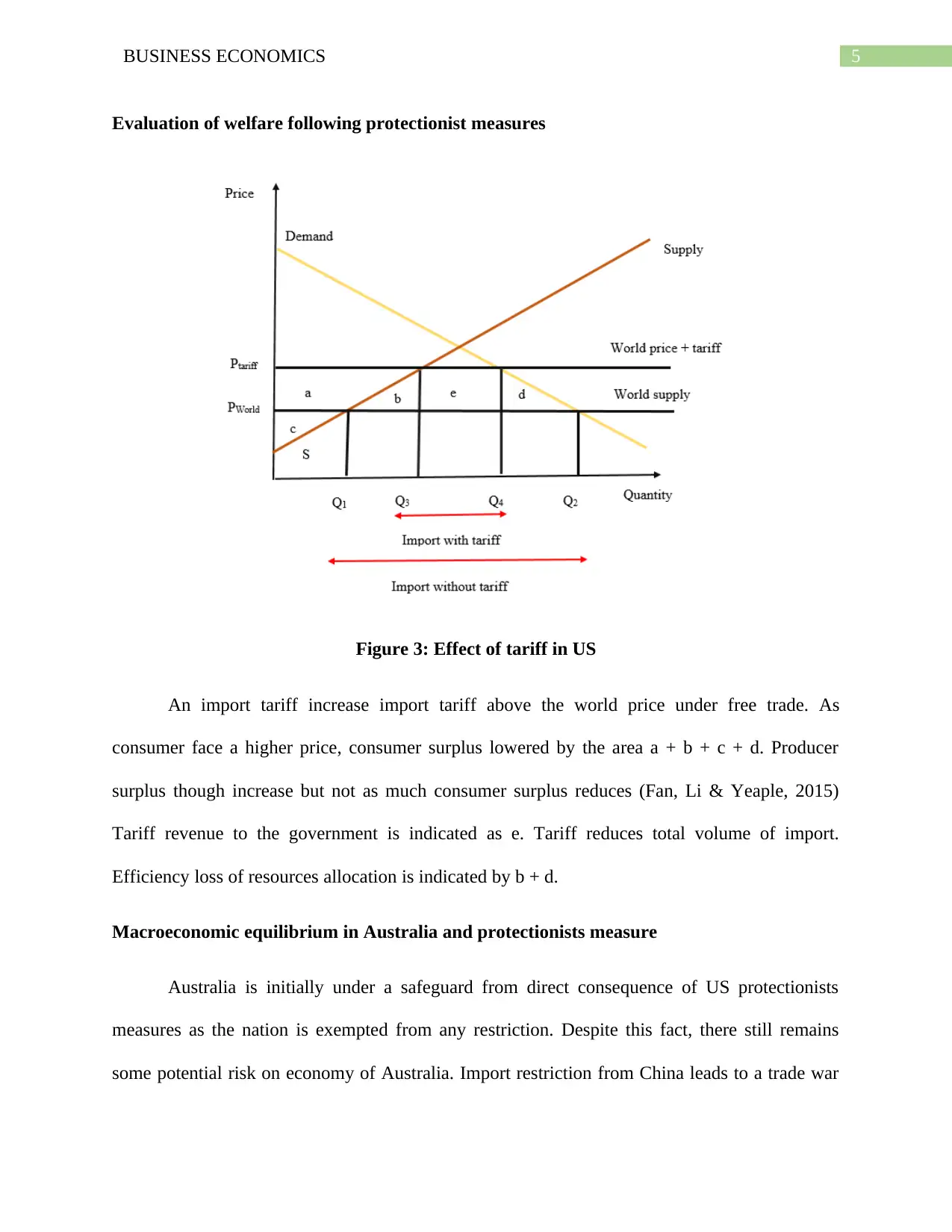
5BUSINESS ECONOMICS
Evaluation of welfare following protectionist measures
Figure 3: Effect of tariff in US
An import tariff increase import tariff above the world price under free trade. As
consumer face a higher price, consumer surplus lowered by the area a + b + c + d. Producer
surplus though increase but not as much consumer surplus reduces (Fan, Li & Yeaple, 2015)
Tariff revenue to the government is indicated as e. Tariff reduces total volume of import.
Efficiency loss of resources allocation is indicated by b + d.
Macroeconomic equilibrium in Australia and protectionists measure
Australia is initially under a safeguard from direct consequence of US protectionists
measures as the nation is exempted from any restriction. Despite this fact, there still remains
some potential risk on economy of Australia. Import restriction from China leads to a trade war
Evaluation of welfare following protectionist measures
Figure 3: Effect of tariff in US
An import tariff increase import tariff above the world price under free trade. As
consumer face a higher price, consumer surplus lowered by the area a + b + c + d. Producer
surplus though increase but not as much consumer surplus reduces (Fan, Li & Yeaple, 2015)
Tariff revenue to the government is indicated as e. Tariff reduces total volume of import.
Efficiency loss of resources allocation is indicated by b + d.
Macroeconomic equilibrium in Australia and protectionists measure
Australia is initially under a safeguard from direct consequence of US protectionists
measures as the nation is exempted from any restriction. Despite this fact, there still remains
some potential risk on economy of Australia. Import restriction from China leads to a trade war
⊘ This is a preview!⊘
Do you want full access?
Subscribe today to unlock all pages.

Trusted by 1+ million students worldwide
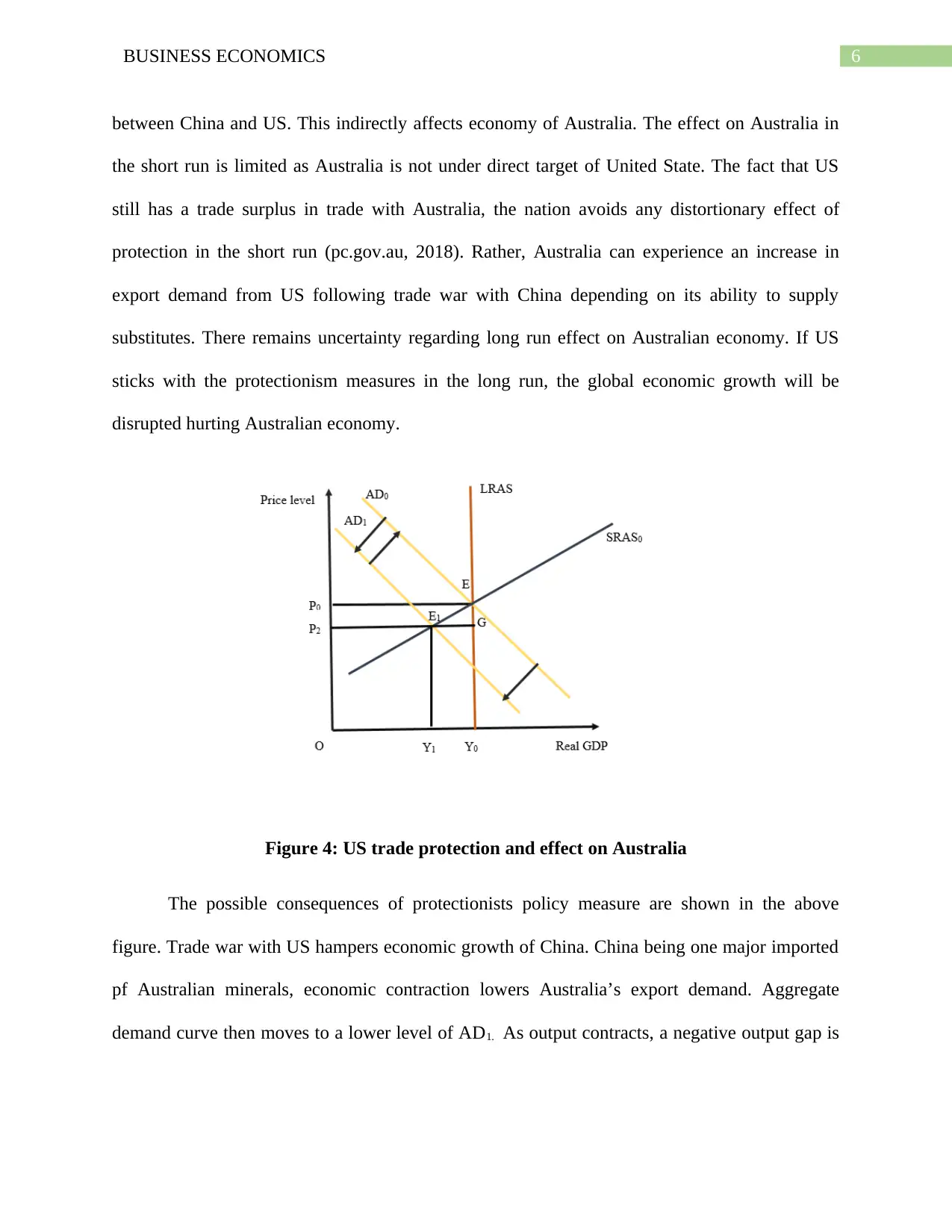
6BUSINESS ECONOMICS
between China and US. This indirectly affects economy of Australia. The effect on Australia in
the short run is limited as Australia is not under direct target of United State. The fact that US
still has a trade surplus in trade with Australia, the nation avoids any distortionary effect of
protection in the short run (pc.gov.au, 2018). Rather, Australia can experience an increase in
export demand from US following trade war with China depending on its ability to supply
substitutes. There remains uncertainty regarding long run effect on Australian economy. If US
sticks with the protectionism measures in the long run, the global economic growth will be
disrupted hurting Australian economy.
Figure 4: US trade protection and effect on Australia
The possible consequences of protectionists policy measure are shown in the above
figure. Trade war with US hampers economic growth of China. China being one major imported
pf Australian minerals, economic contraction lowers Australia’s export demand. Aggregate
demand curve then moves to a lower level of AD1. As output contracts, a negative output gap is
between China and US. This indirectly affects economy of Australia. The effect on Australia in
the short run is limited as Australia is not under direct target of United State. The fact that US
still has a trade surplus in trade with Australia, the nation avoids any distortionary effect of
protection in the short run (pc.gov.au, 2018). Rather, Australia can experience an increase in
export demand from US following trade war with China depending on its ability to supply
substitutes. There remains uncertainty regarding long run effect on Australian economy. If US
sticks with the protectionism measures in the long run, the global economic growth will be
disrupted hurting Australian economy.
Figure 4: US trade protection and effect on Australia
The possible consequences of protectionists policy measure are shown in the above
figure. Trade war with US hampers economic growth of China. China being one major imported
pf Australian minerals, economic contraction lowers Australia’s export demand. Aggregate
demand curve then moves to a lower level of AD1. As output contracts, a negative output gap is
Paraphrase This Document
Need a fresh take? Get an instant paraphrase of this document with our AI Paraphraser
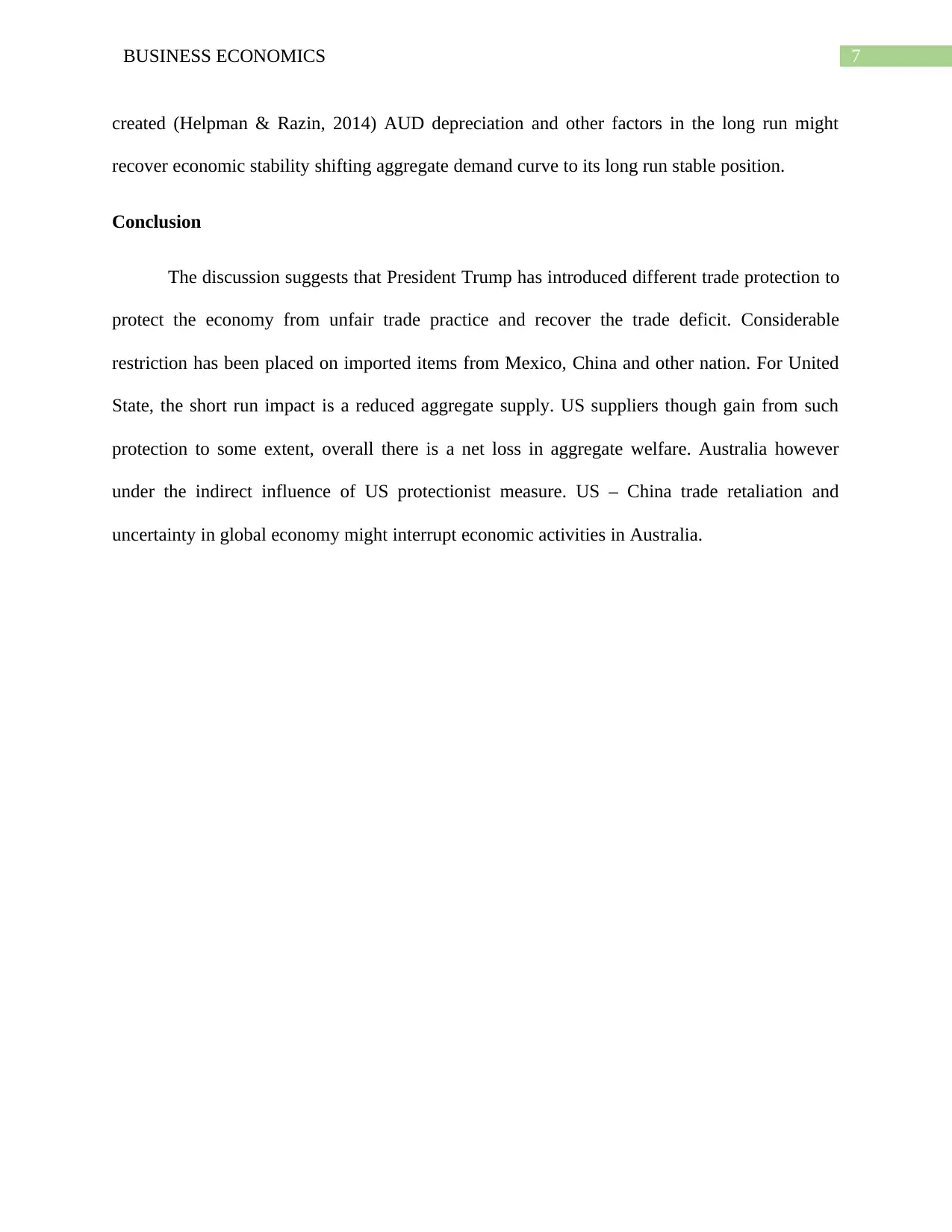
7BUSINESS ECONOMICS
created (Helpman & Razin, 2014) AUD depreciation and other factors in the long run might
recover economic stability shifting aggregate demand curve to its long run stable position.
Conclusion
The discussion suggests that President Trump has introduced different trade protection to
protect the economy from unfair trade practice and recover the trade deficit. Considerable
restriction has been placed on imported items from Mexico, China and other nation. For United
State, the short run impact is a reduced aggregate supply. US suppliers though gain from such
protection to some extent, overall there is a net loss in aggregate welfare. Australia however
under the indirect influence of US protectionist measure. US – China trade retaliation and
uncertainty in global economy might interrupt economic activities in Australia.
created (Helpman & Razin, 2014) AUD depreciation and other factors in the long run might
recover economic stability shifting aggregate demand curve to its long run stable position.
Conclusion
The discussion suggests that President Trump has introduced different trade protection to
protect the economy from unfair trade practice and recover the trade deficit. Considerable
restriction has been placed on imported items from Mexico, China and other nation. For United
State, the short run impact is a reduced aggregate supply. US suppliers though gain from such
protection to some extent, overall there is a net loss in aggregate welfare. Australia however
under the indirect influence of US protectionist measure. US – China trade retaliation and
uncertainty in global economy might interrupt economic activities in Australia.
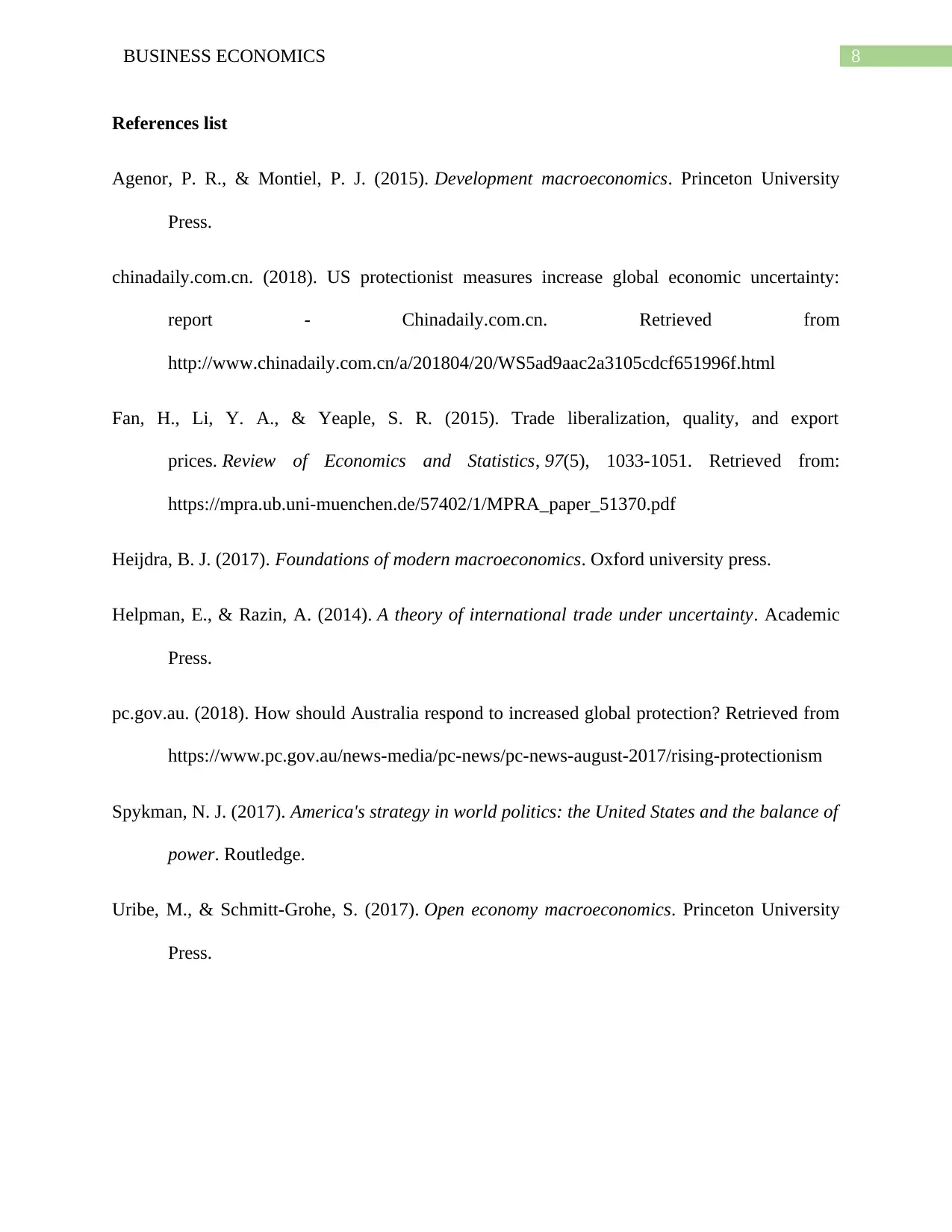
8BUSINESS ECONOMICS
References list
Agenor, P. R., & Montiel, P. J. (2015). Development macroeconomics. Princeton University
Press.
chinadaily.com.cn. (2018). US protectionist measures increase global economic uncertainty:
report - Chinadaily.com.cn. Retrieved from
http://www.chinadaily.com.cn/a/201804/20/WS5ad9aac2a3105cdcf651996f.html
Fan, H., Li, Y. A., & Yeaple, S. R. (2015). Trade liberalization, quality, and export
prices. Review of Economics and Statistics, 97(5), 1033-1051. Retrieved from:
https://mpra.ub.uni-muenchen.de/57402/1/MPRA_paper_51370.pdf
Heijdra, B. J. (2017). Foundations of modern macroeconomics. Oxford university press.
Helpman, E., & Razin, A. (2014). A theory of international trade under uncertainty. Academic
Press.
pc.gov.au. (2018). How should Australia respond to increased global protection? Retrieved from
https://www.pc.gov.au/news-media/pc-news/pc-news-august-2017/rising-protectionism
Spykman, N. J. (2017). America's strategy in world politics: the United States and the balance of
power. Routledge.
Uribe, M., & Schmitt-Grohe, S. (2017). Open economy macroeconomics. Princeton University
Press.
References list
Agenor, P. R., & Montiel, P. J. (2015). Development macroeconomics. Princeton University
Press.
chinadaily.com.cn. (2018). US protectionist measures increase global economic uncertainty:
report - Chinadaily.com.cn. Retrieved from
http://www.chinadaily.com.cn/a/201804/20/WS5ad9aac2a3105cdcf651996f.html
Fan, H., Li, Y. A., & Yeaple, S. R. (2015). Trade liberalization, quality, and export
prices. Review of Economics and Statistics, 97(5), 1033-1051. Retrieved from:
https://mpra.ub.uni-muenchen.de/57402/1/MPRA_paper_51370.pdf
Heijdra, B. J. (2017). Foundations of modern macroeconomics. Oxford university press.
Helpman, E., & Razin, A. (2014). A theory of international trade under uncertainty. Academic
Press.
pc.gov.au. (2018). How should Australia respond to increased global protection? Retrieved from
https://www.pc.gov.au/news-media/pc-news/pc-news-august-2017/rising-protectionism
Spykman, N. J. (2017). America's strategy in world politics: the United States and the balance of
power. Routledge.
Uribe, M., & Schmitt-Grohe, S. (2017). Open economy macroeconomics. Princeton University
Press.
⊘ This is a preview!⊘
Do you want full access?
Subscribe today to unlock all pages.

Trusted by 1+ million students worldwide
1 out of 9
Related Documents
Your All-in-One AI-Powered Toolkit for Academic Success.
+13062052269
info@desklib.com
Available 24*7 on WhatsApp / Email
![[object Object]](/_next/static/media/star-bottom.7253800d.svg)
Unlock your academic potential
Copyright © 2020–2025 A2Z Services. All Rights Reserved. Developed and managed by ZUCOL.




